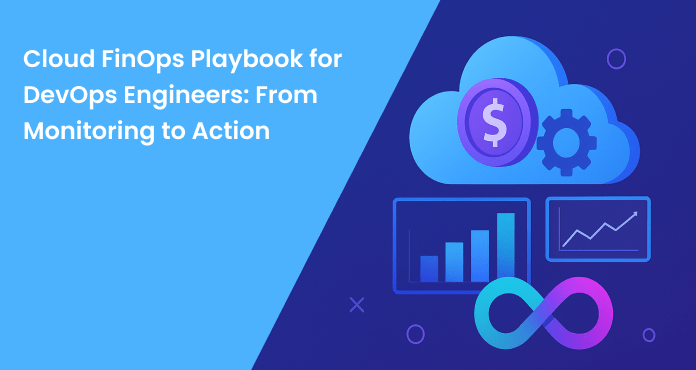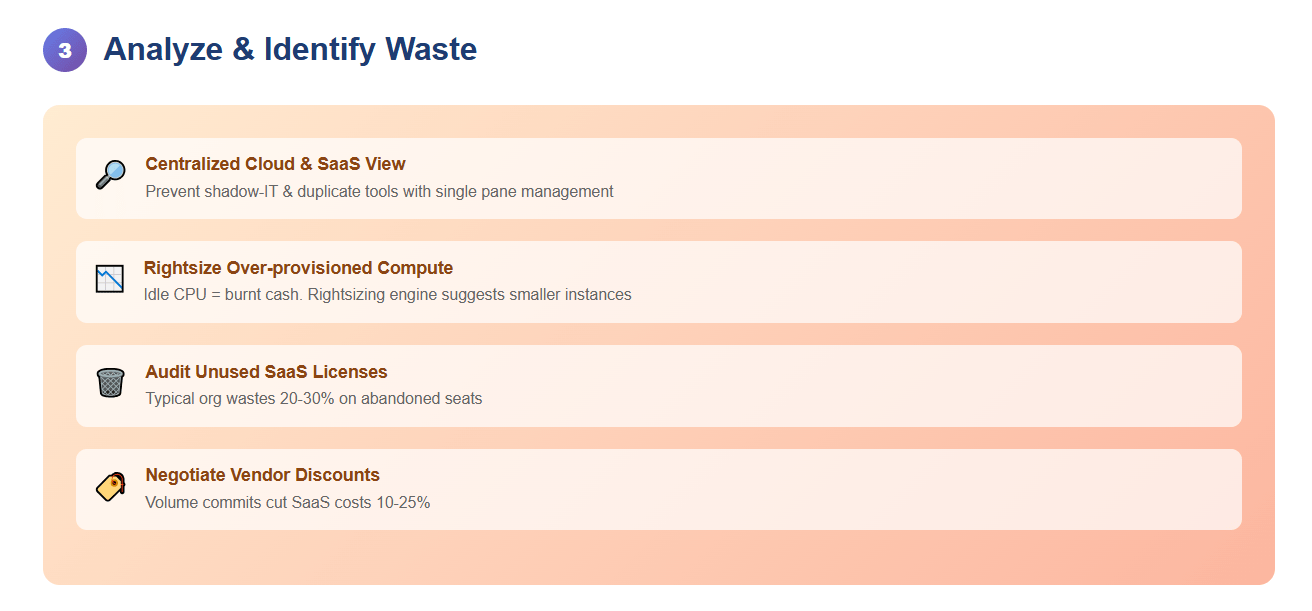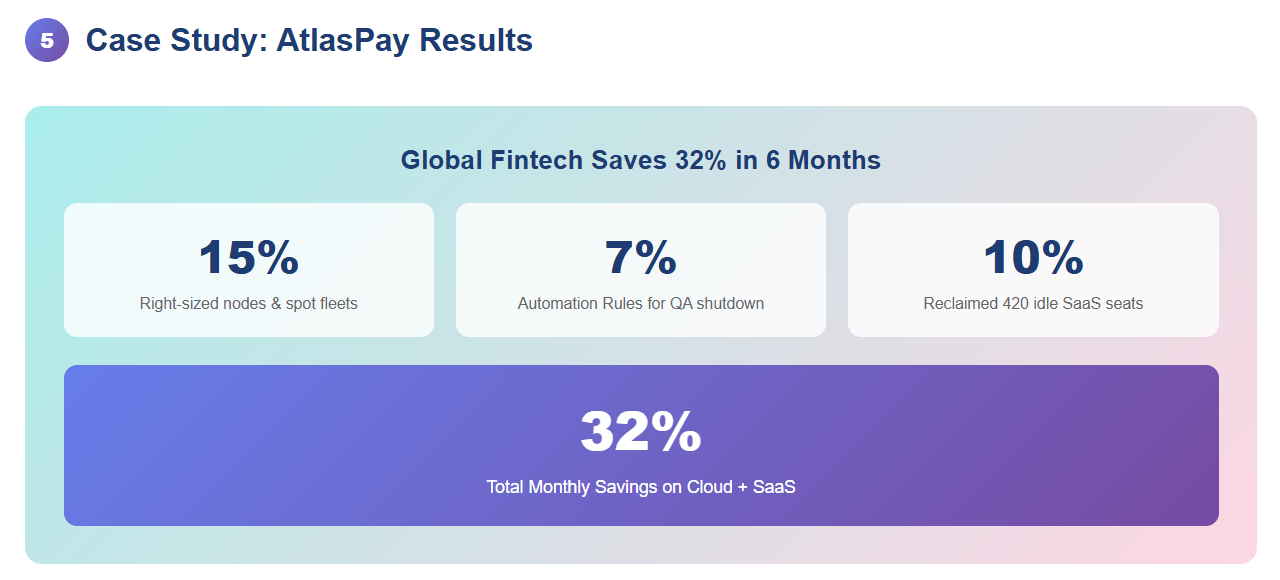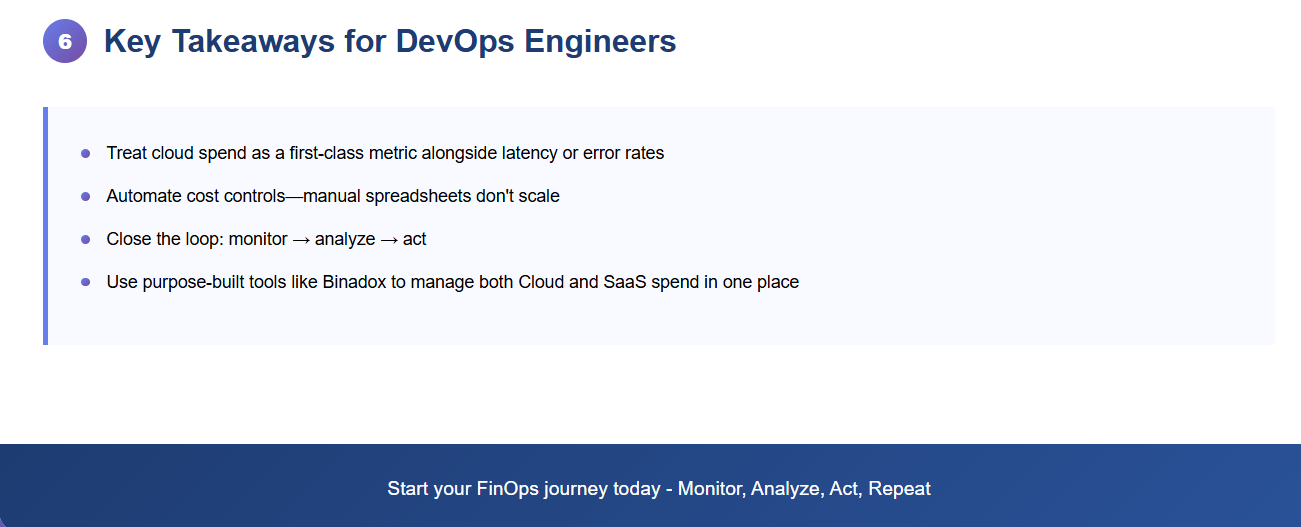
Why DevOps needs a Cloud FinOps mindset
Modern DevOps teams deploy fast, but every new micro‑service, test environment or SaaS integration lands on the cloud bill the very next hour. Cloud FinOps brings financial accountability into the engineering workflow so teams can:
- See exactly where Cloud and SaaS money goes, in real time.
- Understand unit‑economics per feature, environment or customer.
- Act automatically—right‑size, shut down, or re‑architect—before waste snowballs.
(For a refresher on essential Cloud terms, check our Cloud Computing Terminology cheat‑sheet.)

The three FinOps phases every engineer should know
- Inform → collect granular telemetry and allocate every dollar to a cost‑center.
- Optimize → use insights to eliminate waste, right‑size, and negotiate better pricing.
- Operate → embed policy‑as‑code and continuous checks so savings persist.
Practically, this means baking financial KPIs inside your CI/CD pipeline. Track cost‑per‑deployment, reserved‑instance coverage, and SaaS cost‑per‑active‑user alongside the familiar four golden signals. When a new release doubles execution cost, the red flag appears in the same Slack channel that announces build success — making spend as visible as latency.
Build the Observability Layer — Monitor Everything
“You can’t optimise what you can’t measure.”
| Key telemetry | Binadox feature | DevOps win |
|---|---|---|
| Multi‑cloud spend by account, tag, or B‑Tag | Cloud Utilization Dashboard + Spend‑by‑Tags | Pinpoint runaway projects instantly |
| Daily budget & anomaly detection | Cost Explorer | Detect cost spikes in minutes, not weeks |
| Upcoming renewals & SaaS licence usage | License Manager + Renewals Calendar | Avoid surprise invoices; de‑provision unused seats |

Implementation tip:
Instrument your CI/CD pipeline to push
environment,featureandownertags automatically so every new resource is born “traceable”. Municipally enforced tagging policies in Binadox’s Issues scanner prevent un‑tagged resources from ever leaving staging.
Going deeper on observability
Beyond basic cost collection, high‑maturity FinOps teams integrate:
- Real‑time budgeting APIs — emit
cost‑per‑commitmetrics to Prometheus and setalertmanagerrules that fire if an individual change exceeds 5 % of yesterday’s baseline. - Distributed tracing + cost headers— inject estimated $ spent into each span so product managers see cloud burn next to latency in Jaeger.
- OpenCost or CloudWatch GetCostAndUsage APIs— feed raw data into Binadox for cross‑cloud normalization and richer visualizations.
Analyse & Identify Waste
With dashboards live, run a weekly FinOps stand‑up to turn data into decisions.
| Checklist | Why it matters | Binadox help |
|---|---|---|
| 🔎 Centralised view of Cloud & SaaS | Prevent shadow‑IT & duplicate tools | Single pane for cloud + 40+ SaaS connectors |
| 📉 Rightsize over‑provisioned compute | Idle CPU = burnt cash | Rightsizing engine suggests smaller instance types |
| 🗑️ Audit unused SaaS licences | Typical org wastes 20–30 % on abandoned seats | License Manager surfacing user‑level utilisation |
| 🏷️ Negotiate vendor discounts | Volume commits cut SaaS costs 10–25 % | Spend reports back enterprise pricing talks |

Forecast before you refactor
Use Binadox’s predictive models to compare expected end‑of‑month spend with the engineering roadmap. If a looming feature flags a 40 % jump, you can:
- Move stateless components to spot instances.
- Introduce data‑tier auto‑pause windows.
- Update Terraform modules with cheaper ARM‑based instance types.
That conversation happens before tickets reach sprint planning instead of after finance receives an eye‑watering bill.
Waste categories cheat‑sheet
- Overprovisioned compute — CPU avg < 20 %.
- Orphaned storage — unattached EBS volumes/S3 buckets older than 30 days.
- Zombie workloads — forgotten dev clusters with zero traffic for 7 days.
- Idle SaaS seats — users inactive ≥ 45 days.
From Insights to Action
1 Policy‑Driven Automation
Automation Rules in Binadox let you encode guard‑rails as YAML—no servers required:
rule: shutdown_dev_after_hours
when:
tag: environment = dev
time: '19:00‑08:00'
then:
action: stop_resource
notify: slack://#finopsAt 7 p.m. local time non‑production clusters are powered down, saving ~65 % on compute and licensing.
2 Continuous Rightsizing
Rightsizing tasks are emitted as Git‑style pull requests to the infrastructure repo. Engineers review, merge, and watch savings roll in—no separate ticket backlog needed. The approval discussion is captured in GitHub just like any code change, so tribal FinOps knowledge becomes searchable history.
3 Infrastructure‑as‑Code Cost Tracker
When Terraform plans run, Binadox’s IaC Cost Tracker shows the dollar impact before you apply. PRs that balloon spend beyond a configurable threshold fail the pipeline with a helpful comment:
“Plan increases monthly cost by $4 237 — exceeds
team‑alphabudget target by 31 %. Please attach rationale or optimise.”
Developers learn the cheapest play on the board in near real‑time, aligning technical and financial excellence.
4 ChatOps & Human‑in‑the‑loop
Not every suggestion should be auto‑approved. Binadox pipes anomalies to Slack or Microsoft Teams with one‑click “apply” buttons. Senior engineers can add context (“keep xlarge nodes until load‑test”) while still keeping mean‑time‑to‑save under ten minutes.
Establish the FinOps Flywheel
- Monitor — real‑time Cloud & SaaS observability.
- Analyse — weekly reviews surface waste and optimisation opportunities.
- Act — automated rules & IaC guard‑rails apply fixes.
- Repeat — close the loop each sprint; FinOps becomes part of your Definition of Done.

People make the process work
A mature FinOps culture needs clearly defined roles:
- FinOps Champion — evangelises best practices and owns dashboards.
- Engineering Leads — embed cost KPIs in sprints and approve rightsizing PRs.
- Finance Partner — verifies savings and updates rolling forecasts.
- Product Owner — weighs cost vs. customer value in prioritisation.
Get Started Today
Spin up a Binadox trial in <10 min and import AWS, Azure, GCP or Kubernetes costs alongside your SaaS stack.
- Create workspace → connect cloud accounts with read‑only IAM roles.
- Add SaaS connectors (Zoom, Salesforce, GitHub, 40 + out‑of‑the‑box).
- Invite stakeholders to the
#finops‑war‑roomSlack channel. - Schedule your first FinOps stand‑up for Friday.
You’ll immediately see potential savings on idle resources, a live Cloud Utilization Dashboard with daily budget burn, and a SaaS renewal calendar that stops surprise auto‑renewals.
Case study: AtlasPay cuts cloud & SaaS spend by 32 %
Global fintech AtlasPay ran highly elastic Kubernetes clusters across three regions and handed out SaaS licences like candy during hyper‑growth. In six months of using Binadox:
- Over‑sized nodes were right‑sized or moved to spot fleets — 15 % reduction.
- Automation Rules shut down QA environments nightly — 7 % reduction.
- License Manager reclaimed 420 idle SaaS seats — 10 % reduction.

Total savings: 32 % of monthly cloud + SaaS bill, re‑invested into new fraud‑detection features that shipped without additional budget.
Key take‑aways for DevOps Engineers
- Treat cloud spend as a first‑class metric alongside latency or error rates.
- Automate cost controls—manual spreadsheets don’t scale.
- Close the loop: monitor → analyse → act.
- Use purpose‑built tools like Binadox to manage both Cloud and SaaS spend in one place.


